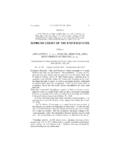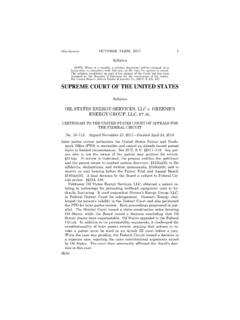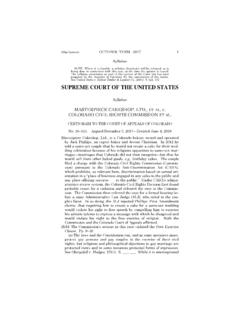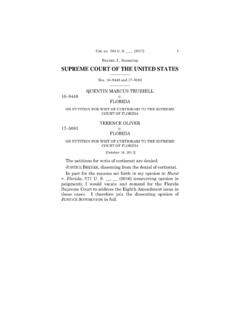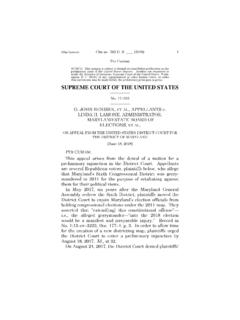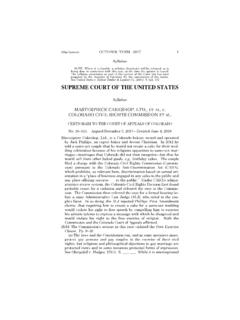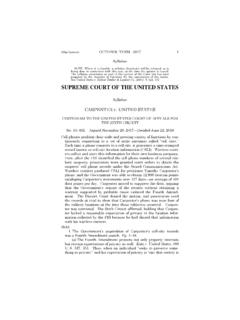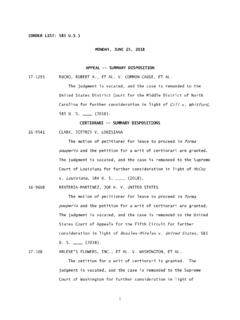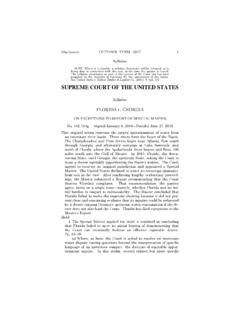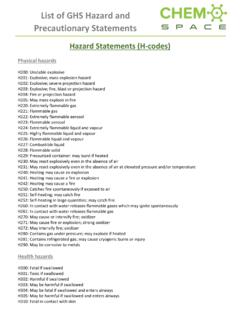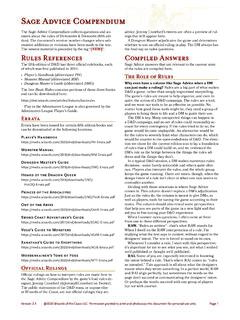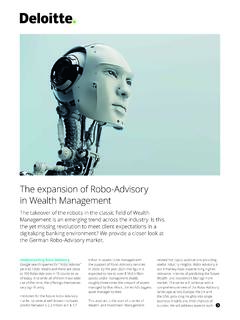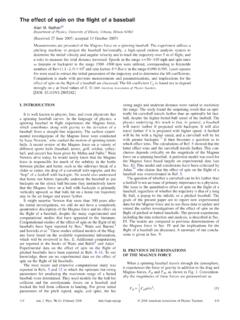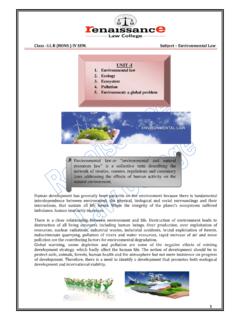Transcription of SUPREME COURT OF THE UNITED STATES
1 Cite as: 592 U. S. ____ (2020) 1 Per Curiam SUPREME COURT OF THE UNITED STATES _____ No. 20A87 _____ ROMAN CATHOLIC DIOCESE OF BROOKLYN, NEW YORK v. ANDREW M. CUOMO, GOVERNOR OF NEW YORK ON APPLICATION FOR INJUNCTIVE RELIEF [November 25,2020] PER CURIAM. The application for injunctive relief presented to JUSTICE BREYER and by him referred to the COURT is granted. Re-spondent is enjoined from enforcing Executive Order s 10- and 25-person occupancy limits on applicant pending disposition of the appeal in the UNITED STATES COURT of Appeals for the Second Circuit and disposition of the petition for a writ of certiorari, if such writ is timely sought. Should the petition for a writ of certiorari be de-nied, this order shall terminate automatically.
2 In the event the petition for a writ of certiorari is granted, the order shall terminate upon the sending down of the judgment of this COURT . * * * * * * This emergency application and another, Agudath Israel of America, et al. v. Cuomo, No. 20A90, present the same issue, and this opinion addresses both cases. Both applications seek relief from an Executive Order is-sued by the Governor of New York that imposes very severe restrictions on attendance at religious services in areas classified as red or orange zones. In red zones, no more than 10 persons may attend each religious service, and in orange zones, attendance is capped at 25. The two applica-tions, one filed by the Roman Catholic Diocese of Brooklyn and the other by Agudath Israel of America and affiliated 2 ROMAN CATHOLIC DIOCESE OF BROOKLYN v.
3 CUOMO Per Curiam entities, contend that these restrictions violate the Free Ex-ercise Clause of the First Amendment, and they ask us toenjoin enforcement of the restrictions while they pursue ap-pellate review. Citing a variety of remarks made by theGovernor, Agudath Israel argues that the Governor specif-ically targeted the Orthodox Jewish community and gerry-mandered the boundaries of red and orange zones to ensurethat heavily Orthodox areas were included. Both the Dio-cese and Agudath Israel maintain that the regulations treathouses of worship much more harshly than comparable sec-ular facilities. And they tell us without contradiction that they have complied with all public health guidance, haveimplemented additional precautionary measures, and haveoperated at 25% or 33% capacity for months without a sin-gle outbreak.
4 The applicants have clearly established their entitlementto relief pending appellate review. They have shown thattheir First Amendment claims are likely to prevail, thatdenying them relief would lead to irreparable injury, and that granting relief would not harm the public interest. See Winter v. Natural Resources Defense Council, Inc., 555 U. S. 7, 20 (2008). Because of the need to issue an order promptly, we provide only a brief summary of the reasons why immediate relief is essential. Likelihood of success on the merits. The applicants havemade a strong showing that the challenged restrictions vi-olate the minimum requirement of neutrality to religion. Church of Lukumi Babalu Aye, Inc. v. Hialeah, 508 U. S. 520, 533 (1993). As noted by the dissent in the COURT below,statements made in connection with the challenged rulescan be viewed as targeting the ultra-Orthodox [Jewish] community.
5 ___ F. 3d ___, ___, 2020 WL 6750495, *5 (CA2, Nov. 9, 2020) (Park, J., dissenting). But even if we put those comments aside, the regulations cannot be viewed 3 Cite as: 592 U. S. ____ (2020) Per Curiam as neutral because they single out houses of worship for es-pecially harsh In a red zone, while a synagogue or church may not admit more than 10 persons, businesses categorized as essential may admit as many people as they wish. And the list of essential businesses includes things such as acupuncture facilities, camp grounds, garages, as well as many whose services are not limited to those that can be regarded as es-sential, such as all plants manufacturing chemicals and mi-croelectronics and all transportation facilities.
6 See New York State, Empire State Development, Guidance for De-termining Whether a Business Enterprise is Subject to a Workforce Reduction Under Recent Executive Orders, The dis-parate treatment is even more striking in an orange attendance at houses of worship is limited to 25 per-sons, even non-essential businesses may decide for them-selves how many persons to admit. These categorizations lead to troubling results. At the hearing in the District COURT , a health department official testified about a large store in Brooklyn that could literally have hundreds of people shopping there on any given day. App. to Application in No. 20A87, Exh. D, p. 83. Yet a nearby church or synagogue would be prohibited from al-lowing more than 10 or 25 people inside for a worship ser-vice.
7 And the Governor has stated that factories and schools have contributed to the spread of COVID 19, id., Exh. H, at 3; App. to Application in No. 20A90, pp. 98, 100, but they are treated less harshly than the Diocese schurches and Agudath Israel s synagogues, which have ad-mirable safety the challenged restrictions are not neutral and 1 Compare Trump v. Hawaii, 585 U. S. ___, ___ (2018) (slip op., at 29) (directive neutral on its face ). 4 ROMAN CATHOLIC DIOCESE OF BROOKLYN v. CUOMO Per Curiam of general applicability, they must satisfy strict scru-tiny, and this means that they must be narrowly tailored to serve a compelling state interest. Church of Lukumi, 508 U. S., at 546. Stemming the spread of COVID 19 isunquestionably a compelling interest, but it is hard to see how the challenged regulations can be regarded as nar-rowly tailored.
8 They are far more restrictive than any COVID related regulations that have previously come be-fore the COURT ,2 much tighter than those adopted by many other jurisdictions hard-hit by the pandemic, and far more severe than has been shown to be required to prevent the spread of the virus at the applicants services. The District COURT noted that there ha[d] not been any COVID 19 out-break in any of the Diocese s churches since they reopened, and it praised the Diocese s record in combatting the spreadof the disease. ___ F. Supp. 3d ___, ___, 2020 WL 6120167, *2 (EDNY, Oct. 16, 2020). It found that the Diocese had been constantly ahead of the curve, enforcing strictersafety protocols than the State required. Ibid. Similarly,Agudath Israel notes that [t]he Governor does not dispute that [it] ha[s] rigorously implemented and adhered to allhealth protocols and that there has been no outbreak of COVID 19 in [its] congregations.
9 Application in , at 36. Not only is there no evidence that the applicants havecontributed to the spread of COVID 19 but there are manyother less restrictive rules that could be adopted to mini-mize the risk to those attending religious services. Amongother things, the maximum attendance at a religious ser-vice could be tied to the size of the church or synagogue. Almost all of the 26 Diocese churches immediately affected 2 See Calvary Chapel Dayton Valley v. Sisolak, 591 U. S. ___ (2020) (di-rective limiting in-person worship services to 50 people); South Bay UNITED Pentecostal Church v. Newsom, 590 U. S. ___ (2020) (ExecutiveOrder limiting in-person worship to 25% capacity or 100 people, which-ever was lower). 5 Cite as: 592 U.
10 S. ____ (2020) Per Curiam by the Executive Order can seat at least 500 people, about14 can accommodate at least 700, and 2 can seat over 1,000. Similarly, Agudath Israel of Kew Garden Hills can seat up to 400. It is hard to believe that admitting more than 10 people to a 1,000 seat church or 400 seat synagogue would create a more serious health risk than the many other ac-tivities that the State allows. Irreparable harm. There can be no question that the challenged restrictions, if enforced, will cause irreparableharm. The loss of First Amendment freedoms, for even minimal periods of time, unquestionably constitutes irrep-arable injury. Elrod v. Burns, 427 U. S. 347, 373 (1976) (plurality opinion). If only 10 people are admitted to eachservice, the great majority of those who wish to attend Masson Sunday or services in a synagogue on Shabbat will bebarred.
